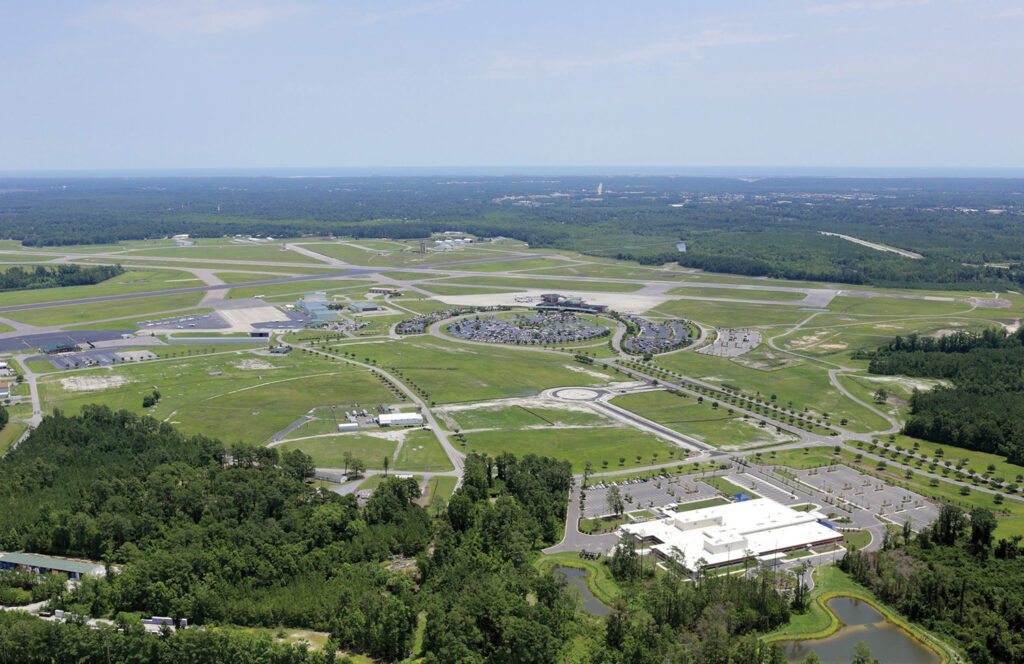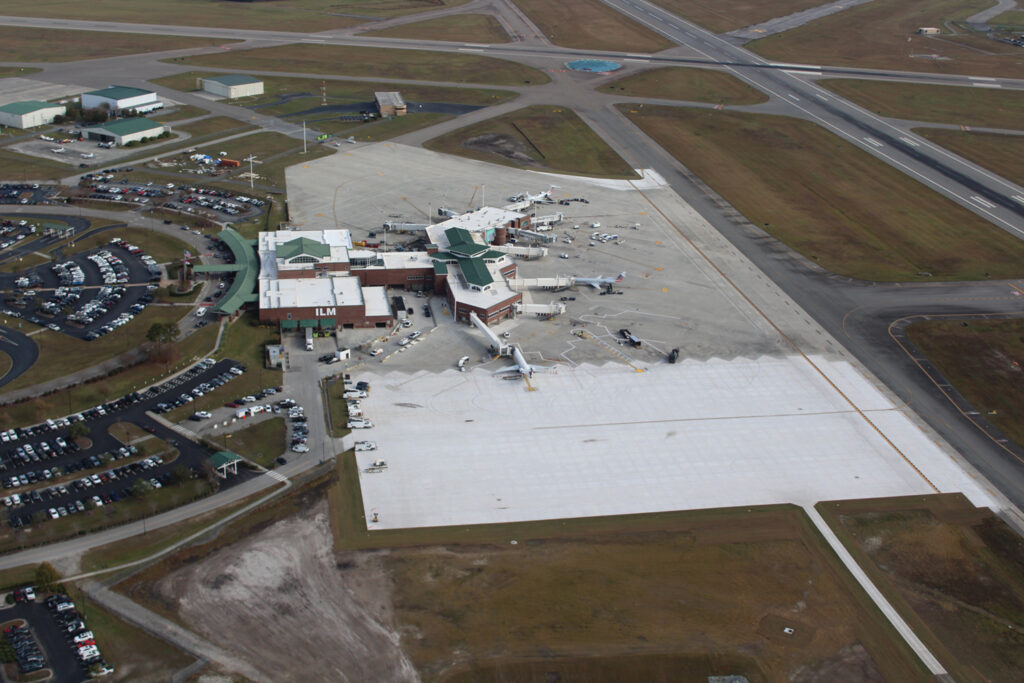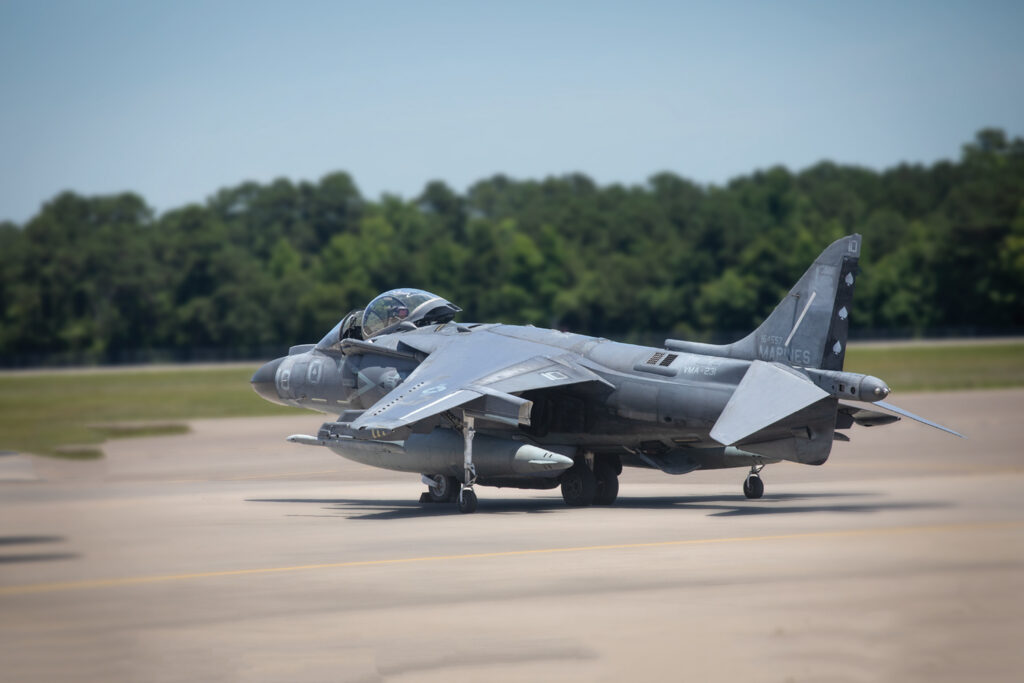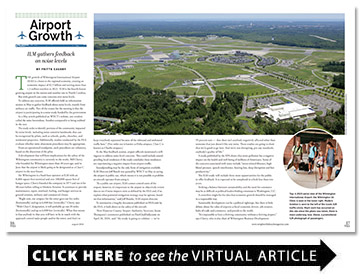Airport Growth
ILM gathers feedback on noise levels
BY Fritts Causby

The growth of Wilmington International Airport (ILM) is a boon to the regional economy, creating an economic impact of $2.5 billion and serving more than 1.3 million travelers in 2023. ILM is the fourth-fastest growing airport in the nation and number one in North Carolina.
But with growth can come concerns over noise levels.
To address any concerns, ILM officials held an information session in May to gather feedback about noise levels, mainly from military air traffic. Part of the reason for the meeting is that the airport is participating in a noise study funded by the government.
In a May article published on WECT’s website, one resident called the noise horrendous. Another compared it to being stabbed in the ears.
The study seeks to identify portions of the community impacted by noise levels, including noise-sensitive landmarks that can be recognized by pilots, such as schools, parks, churches, and residential properties. Additionally, studies conducted by the FAA evaluate whether noise abatement procedures may be appropriate.
From an operational standpoint, such procedures are voluntary, based on the discretion of the pilot.
A development that will have implications for the safety of the Wilmington community is currently in the works. Bill Cherry, who founded Air Wilmington more than 40 years ago, said in June that the airport is likely going to be designated as a Class C airport in the near future.
Air Wilmington is a fixed-base operator at ILM with an 8,400-square-foot terminal and over 100,000 square feet of hangar space. Cherry founded the company in 1975 and ran it for 40 years before selling to Modern Aviation. It continues to provide maintenance, repair, overhaul, fueling, and hanger services to general aviation, military and commercial clients.
“Right now, our airspace for the tower goes out five miles [horizontally] and up to 6,000 feet [vertically],” Cherry says. “With Class C designation, it will probably go out 20 miles [horizontally] and up to 6,000 feet [vertically]. What that means is that anybody in that area will have to be in touch with the approach control radar people and/or the tower, and that’s to keep everybody separated because of the inbound and outbound traffic here.” [Five miles out is known as Delta airspace, Class C is known as Charlie airspace.]
At the May feedback session, airport officials mentioned a willingness to address noise-level concerns. This could include soundproofing local residences if the study concludes these residences are experiencing a negative impact from airport traffic.
Soundproofing may be the only form of mitigation available. ILM Director Jeff Bourk was quoted by WECT in May as saying the airport is public use, which means it is not possible to prohibit an aircraft operator from using it.
“As a public use airport, ILM cannot control users of the airport; however, it’s important to the airport to objectively review data to see if noise impacts exist as defined by the FAA and, if so, explore what potential mitigation strategy may be options, based on that information,” said Jeff Bourke, ILM airport director.
To summarize a lengthy document published on FAA.com by the FAA, it boils down to the safety of the aircraft.

Courtesy ILM/BDS Aviation Photography
New Hanover County Airport Authority Secretary Jason Thompson’s comments published on PortCityDaily.com on April 26, 2024, said “the study is going to validate — we’re 95 percent sure — that there isn’t anybody negatively affected other than someone that just doesn’t like any noise. These studies are going to show that we’re good to go here. And we’re not disrupting, per any standards, anybody’s quality of life.”
A study published by the EPA shows that noise pollution has a negative impact on the health and well-being of millions of Americans. Some of the concerns associated with noise include “stress-related illnesses, high blood pressure, speech interference, hearing loss, sleep disruption and lost productivity.”
The ILM study will include three more opportunities for the public to offer feedback. It is expected to be completed in a little less than two years.
Striking a balance between sustainability and the need for commerce may be as difficult as political leaders finding consensus in Washington, D.C.
A centerline might be the idea that economic growth should be managed in a responsible way.
Sustainable development can be a political tightrope, but there is little debate about the value of airports as local economic drivers, job creators, hubs of trade and commerce, and portals to the world.
“It’s impossible to have a thriving community without a thriving airport,” says Cherry, who is also chair of Wilmington Business Development.
The Wilmington metropolitan area was among the top 10 in the country for population growth between July 2022 and July 2023.
“The traffic in the airport has grown as the Wilmington area has grown,” Cherry says. Between 1969 and 2022, the population swelled from around 99,000 to more than 300,000.
An expansion completed recently was designed to handle 1.3 million passengers each year.
“We blew through that number,” said Cherry in late June. “So now they’re going to expand it to handle 1.5 million, which is the number we’re at now.”
To reduce the number of people exposed to significant aviation noise, the FAA is working on a Continuous Lower Energy, Emissions, and Noise (CLEEN) program.
Cherry and Bourke express pride in the growth at ILM, the fastest growing airport in North Carolina and the fourth fastest in the United States.
Capital improvements are slated.
“To accommodate this growing demand, and continue to provide the needed facilities and infrastructure, ILM has a five-year $185 million capital plan,” Bourke says.
The growth of the San Diego International Airport could offer an insight for ILM officials and Wilmington residents. San Diego and Wilmington share a variety of similarities, both depend on tourism, natural beauty, beaches, and the military and tech as economic drivers. Both have experienced significant population growth over the years.
Pilots approaching San Diego typically navigate a labyrinth of skyscrapers, making for an exciting thrill ride or an anxiety-producing nightmare, depending on one’s perspective. The takeoff zone is also right in the heart of the city.
There is significant consensus about the need to relocate the airport to the outskirts of the city, but the complexity involved has made it unfeasible.



Several large neighborhoods in the flight path represent extremely valuable real estate.
In Wilmington, Cherry says, “The airport authority has been constantly buying land to let the airport expand and control the growth around the airport.”
Part of the reason is to keep residential neighborhoods away from the airport. Making room for expansion is another reason. In San Diego, the size of the airport is limited. There is no room for terminal expansion or a longer airstrip, which caps airplane size.
“There is plenty of space for expansion [at ILM] and the airstrips could potentially be lengthened if needed,” Cherry says.
Cherry is confident about the level of planning involved with ILM.
“The local air traffic control has also allowed for a reduced footprint and lower noise levels,” he says.
He also shared his experience about the advances in the industry.
“The reduction in the amount of noise over the years is truly amazing, and most of the older planes are gone,” Cherry says.
Older aircraft were mostly piston-driven, a factor that made them louder and more harmful for air quality than modern planes.
The industry is working on new technologies that could potentially have a positive impact. Hybrid engines, electric aircraft, biofuels, and hydrogen-powered aircraft are just a few of the ideas that could take over the skies in the next few decades.
The FAA is working on a program to reduce noise, fuel burn, and emissions. To reduce the number of people exposed to significant aviation noise, the agency is working on a Continuous Lower Energy, Emissions, and Noise (CLEEN) program.
The FAA also is collaborating with communities to eliminate or mitigate incompatible land use near airports and provide federal funds to alleviate the adverse impacts of aircraft noise in homes and schools near airports.
Finding a balance between growth and sustainability may always be a challenge. But a future where planes soar quietly overhead while continuing to provide global access and support local economies might be an idea that gets everyone on board.

